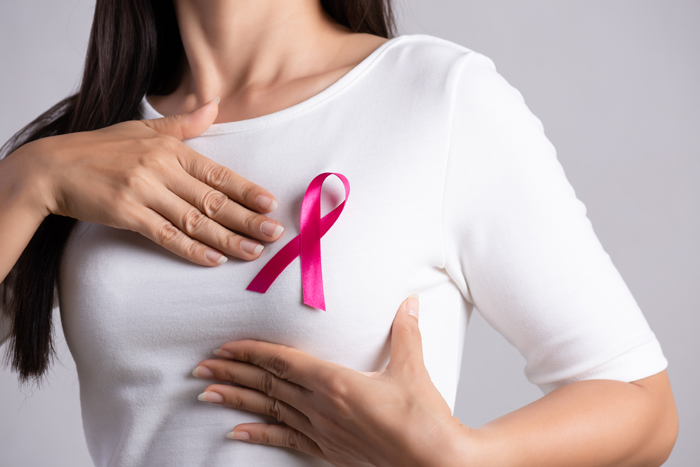Like all tissues and organs in the human body, the female breasts are multidimensional in function. Their most recognized part is as exocrine glands, producing breast milk for newborns, a process common to all mammalian species. Given the multifaceted functions of the breasts, a discussion of breast health approaches could be complex. Therefore, this article will limit our discussion to what women can do from the Ayurvedic perspective to reduce their chances of developing the most dangerous breast disease: breast cancer.
First, let’s briefly review some simple breast anatomy. Mammary glands are highly modified and specialized sebaceous glands derived from embryonic ectoderm. The adult breast comprises glandular tissue, adipose tissue (fat cells), nerves, blood vessels, and lymphatics. Anatomically, it overlies the pectoralis major muscle and is anchored to the pectoralis fascia by suspensory ligaments known as Cooper’s (not shown).

The breast contains about 15 to 25 lobes formed by “milk glands,” or lobules. Each lobule comprises hollow milk-producing acini (alveoli) and feeds into a milk duct leading to the nipples. The ducts converge near the areola, the darker area around the nipple, to form ampulla or milk storage cavities. Around the areola are small glands known as Montgomery’s, which secrete an oily substance that protects the nipples during nursing. Lymph nodes within the breast drain into the axillary lymph nodes in the armpit, the first place to which breast cancer will typically metastasize.
What Is Breast Cancer? The Western View
Cancer is fundamentally a disease of failure of regulation of tissue growth. For a normal cell to transform into a cancer cell, the genes that regulate cell growth and differentiation must be altered. A gene is a specific sequence of DNA at a particular location of a specific chromosome. Only 5-10% of breast cancers are inherited; the vast majority are due to sporadic, acquired mutations Yarlesac.
The affected genes are divided into two broad categories. Oncogenes are genes that promote cell growth and reproduction, and tumor suppressor genes are genes that inhibit cell division and survival. Malignant transformation can occur through the formation of abnormal oncogenes, the inappropriate over-expression of normal oncogenes, or the under-expression or complete arrest of tumor suppressor genes. Typically, changes in many genes are required to transform a normal cell into a cancer cell.
Large-scale mutations involve a deletion or gain of a portion of a chromosome. Gene amplification occurs when a cell gains many copies (often 20 or more) of a small chromosomal locus, usually containing one or more oncogenes and adjacent genetic material. Translocation occurs when two chromosomal regions become abnormally fused, often at a distinct location. Disruption of a single gene may also result from integrating genomic material from a DNA virus or retrovirus and resulting in the expression of viral oncogenes in the affected cell and its descendants, but this is not the case in breast cancer.
The transformation of normal breast cells into cancer is akin to a chain reaction caused by initial errors, compounding into more severe errors, each progressively allowing the cell to escape the controls that limit average tissue growth. This renegade-like scenario causes an undesirable survival of the fittest, where the natural forces of evolution become distorted and work against the body’s design and harmonious order. Suppose the rate of DNA damage exceeds the capacity of the cell to repair it. In that case, the accumulation of errors can overwhelm the cell and result in early senescence, apoptosis, or cancer. Once cancer has begun to develop, it uses the body’s design to serve its own destructive and invasive purposes.
READ MORE :
- Health Care Fraud – The Perfect Storm
- 10 Things to Hate About the iPhone
- Health Care Reform is Not Healthy
- Should There Be an App for That?
- Breast Cancer: Fancy Gadget and Half A Million Ringgit Failed to Cure Her – What Now?











